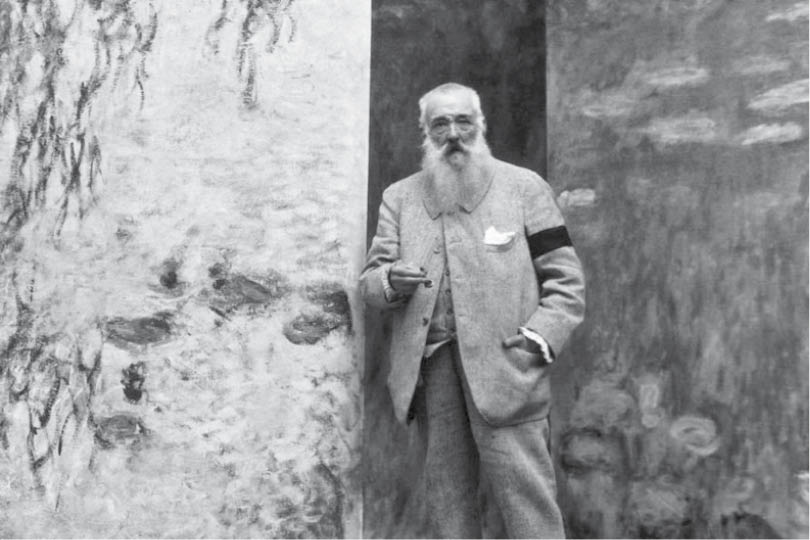‘It just sucks you in’: Monet’s most famous painting is now in Canberra
M onet’s Impression, Sunrise is showing in the southern hemisphere for the first time, to celebrate new discoveries made about the work. When Claude Monet was buried at the age of 86, French statesman Georges Clemenceau was horrified to see a black shroud covering his coffin. “No black for Monet!” he cried, ripping it off, […]

The late Claude Monet
| M |
onet’s Impression, Sunrise is showing in the southern hemisphere for the first time, to celebrate new discoveries made about the work.
When Claude Monet was buried at the age of 86, French statesman Georges Clemenceau was horrified to see a black shroud covering his coffin. “No black for Monet!” he cried, ripping it off, before he covered his friend with a brighter cloth instead.
Monet was, of course, a master of colour: a man obsessed with the emerald green of water lilies or the blue of a pond, subjects he drew obsessively, again and again.
Now his most famous painting of all – Impression, Soleil Levant or Impression, Sunrise – is being shown in the southern hemisphere for the first time.
Monet: Impression Sunrise, which opened this week at the National Gallery of Australia (NGA), tracks Monet’s early inspirations and influences. It also shows later works of the French master including Haystacks, Midday (1890) and Waterlillies (1914-17), both of which are in the NGA collection.
The centerpiece, however, is 1872’s Impression, Sunrise – the image that inadvertently gave the impressionists their name.
“It is modest in scale but its role and its position in art history is enormous,” says NGA director Nick Mitzevich. “Australian audiences have a good knowledge of Impressionism, but this is the missing part of the puzzle.”
“I think it’s like a little exquisite jewel – it just sucks you in. That’s the mastery of Monet: these simple brush strokes, these very carefully applied bits of raw colour. The shadowy stacks of boats and industry as the sun is rising. You get this sense of an early morning moment through fleeting bits of colour and brushstrokes.”
Musée Marmottan Monet, owners of the largest Monet collection in the world, rarely loan out Impression, Sunrise – and usually only for a month at a time.
The work, however, will be on show in Canberra for almost triple that time in a new 650 sq m space reserved for temporary exhibitions. The extended exhibition length is largely a bid to highlight research that the Musée Marmottan Monet conducted on the painting in 2014, to celebrate the 80th anniversary of its opening.
Among other things, Marmottan Monet has pinpointed the exact location of the view of the port of Le Havre that Monet painted in Impression, Sunrise. It also established that the picture depicts sunrise, not sunset – a matter that had divided art historians.
Impression, Sunrise is not only significant for its beauty – with its depiction of a bright orange sun rising above a hazy sea – but for the name it gave to impressionism.
In 1898, Monet told La Revue Illustrée how he came up with the title: “They wanted to know its title for the catalogue [because] it couldn’t really pass for a view of Le Havre. I replied: ‘Use impression’.”
NGA’s Simeron Maxwell assisted the exhibition’s curator Marianne Mathieu, scientific director of the Musée Marmottan Monet. Maxwell explains that in the late 19th century the word “impression” was “a common term to mean a really quick sketch of something: ‘impressions’ were not to be exhibited, they were not seen as finished works. But Monet turned that on his head and said why isn’t it finished?”
While critics were, on the whole, unimpressed by Impression, Sunrise when it was first exhibited in 1874, Monet now commands huge prices. Meules, a painting in his seminal Haystacks series, was auctioned last month by a private collector for US$110.7m (A$160m) – making it the most expensive impressionist painting ever sold, according to Sotheby’s.
Other artists included in the NGA exhibition – who either influenced Monet or were influenced by him – range from English painter JMW Turner to female impressionist Berthe Morisot. Frenchman Eugène Boudin, who encouraged Monet to take up landscape painting and to paint outdoors alongside him, also features.
Many of the 60 works on display have been borrowed from the Musée Marmottan Monet as well as London’s Tate. Private collections in Australia, New Zealand, the UK and US have also lent works.
Mitzevich hopes that Monet: Impression Sunrise will give local audiences “an insight into where impressionism came from.”
“The show is a meditation on one painting and it’s before and after,” he says. “We literally walk you through his inspiration.”
- Monet: Impression Sunrise is open at the NGA until 1 September
Source: TheGuardian.com
